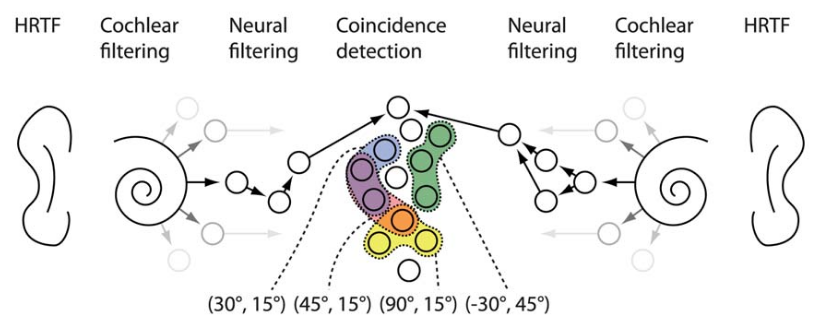Sensory neuroscience

Sensory neuroscience is the study of how the brain processes sensory information, such as sight, sound, touch, etc. Some of the main aspects of our work are:
- Spike-based computation. The brain computes using precisely timed but discrete events called spikes. This mode of computation is different from both traditional analogue and digital computation, and presumably offers benefits compared to them. However, despite several interesting hypotheses and specific models, there is as yet not comprehensive theory of this form of computation.
- Auditory system. As we are interested in computation with precisely timed spikes, the auditory system is a natural one to study as the role of precise temporal information is so well established there.
- Realistic environments. We are interested in how sensory processing is done in realistic rather than laboratory environments. Specifically, rather than using simplified stimuli such as pure tones, we prefer to analyse the processing of complex stimuli such as natural sounds in a noisy background. We are also interested in the problem of processing a continuous stream of sensory data rather than the typical laboratory problem of responding to a brief, precisely delineated stimuli.
We are interested in both fundamental research into these problems, and applications in areas such as robotics and automatic speech recognition.
Related organisations
Related software
Related videos
-
Nonlinearity and network topology in multimodal circuitsTalk / 2024
Marcus Ghosh talk at ICNS -
Multimodal units fuse-then-accumulate evidence across channelsTalk / 2023
Talk on multimodal processing given at VVTNS 2023 seminar series -
The Psychometrics of Automatic Speech RecognitionTalk / 2022
Talk on applying psychometric testing to automatic speech recognition systems. -
Understanding the role of neural heterogeneity in learningTalk / 2021
Talk on neural heterogeneity by Nicolas Perez. -
Neural heterogeneity promotes robust learningTalk / 2021
Talk on neural heterogeneity by Dan Goodman. -
Binaural sound localisation game demoDemo / 2016
Demo of binaural sound localisation virtual reality game.
Related publications
2025
-
Chu Y, Luk W, Goodman DFM (2025)
Learning spatial hearing via innate mechanisms.
PLoS Computational Biology -
Ghosh M, et al. (2025)
Spiking neural network models of interaural time difference extraction via a massively collaborative process.
eNeuro -
Anil S, Goodman DFM, Ghosh M (2025)
Fusing multisensory signals across channels and time.
PLoS Computational Biology
2024
-
Ghosh M, Béna G, Bormuth V, Goodman DFM (2024)
Nonlinear fusion is optimal for a wide class of multisensory tasks.
PLoS Computational Biology
2022
-
Weerts L, Rosen S, Clopath C, Goodman DFM
The Psychometrics of Automatic Speech Recognition.
Preprint -
Engel I, Goodman DFM, Picinali L (2022)
Assessing HRTF preprocessing methods for Ambisonics rendering through perceptual models.
Acta Acustica
2021
-
Perez-Nieves N, Leung VCH, Dragotti PL, Goodman DFM (2021)
Neural heterogeneity promotes robust learning.
Nature Communications -
Su Y, Chung Y, Goodman DFM, Hancock KE, Delgutte B (2021)
Rate and Temporal Coding of Regular and Irregular Pulse Trains in Auditory Midbrain of Normal‑Hearing and Cochlear‑Implanted Rabbits.
Journal of the Association for Research in Otolaryngology -
Engel I (2021)
Improving binaural audio techniques for augmented reality.
PhD thesis, Imperial College London -
Weerts L (2021)
Features of hearing: applications of machine learning to uncover the building blocks of hearing.
PhD thesis, Imperial College London
2019
-
Chu Y, Goodman DFM (2019)
An Inference Network Model for Goal-directed Attentional Selection.
Cognitive Computational Neuroscience -
Engel I, Goodman DFM, Picinali L (2019)
The Effect of Auditory Anchors on Sound Localization: A Preliminary Study.
Immersive and Interactive Audio -
Weerts L, Clopath C, Goodman DFM (2019)
A Unifying Framework for Neuro-Inspired, Data-Driven Detection of Low-Level Auditory Features.
Cognitive Computational Neuroscience -
Steadman MA, Kim C, Lestang JH, Goodman DFM, Picinali L (2019)
Short-term effects of sound localization training in virtual reality.
Scientific Reports -
Lestang J-H (2019)
The role of canonical neural computations in sound localization.
PhD thesis, Imperial College London
2018
-
Dietz M, et al. (2018)
A framework for testing and comparing binaural models.
Hearing Research -
Goodman DFM, Winter IM, Léger AC, de Cheveigné A, Lorenzi C (2018)
Modelling firing regularity in the ventral cochlear nucleus: mechanisms, and effects of stimulus level and synaptopathy.
Hearing Research -
Chungeun K, Steadman M, Lestang JH, Goodman DFM, Picinali L (2018)
A VR-Based Mobile Platform for Training to Non-Individualized Binaural 3D Audio.
Audio Engineering Society
2017
-
Goodman DF (2017)
On the use of hypothesis-driven reduced models in auditory neuroscience.
Acoustical Society of America -
Dietz M, et al. (2017)
An initiative for testability and comparability of binaural models.
Acoustical Society of America -
Lestang JH, Goodman DF (2017)
The roles of inhibition and adaptation for spatial hearing in difficult listening conditions.
Acoustical Society of America
2016
-
Dietz M, et al. (2016)
A framework for auditory model comparability and applicability.
Acoustical Society of America
2015
-
Goodman DFM, de Cheveigné A, Winter IM, Lorenzi C (2015)
Downstream changes in firing regularity following damage to the early auditory system.
Computational Neuroscience
2013
-
Goodman DFM, Benichoux V, Brette R (2013)
Decoding neural responses to temporal cues for sound localization.
eLife
2011
-
Fontaine B, Goodman DFM, Benichoux V, Brette R (2011)
Brian Hears: online auditory processing using vectorisation over channels.
Frontiers in Neuroinformatics -
Kremer Y, Léger J-F, Goodman D, Brette R, Bourdieu L (2011)
Late emergence of the vibrissa direction selectivity map in the rat barrel cortex.
Journal of Neuroscience
2010
-
Goodman DFM, Brette R (2010)
Learning to localise sounds with spiking neural networks.
Advances in Neural Information Processing Systems -
Goodman DFM, Brette R (2010)
Spike-timing-based computation in sound localization.
PLoS Computational Biology